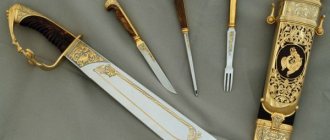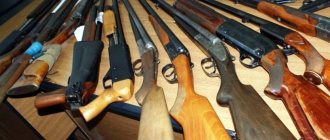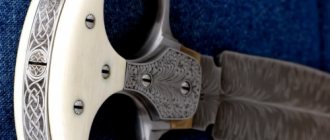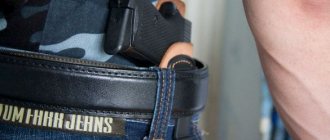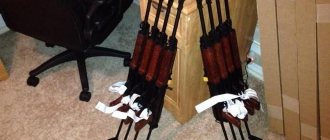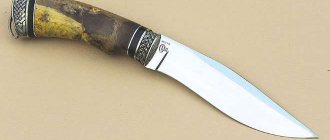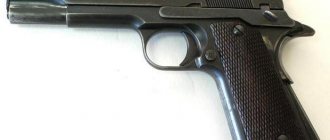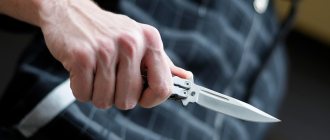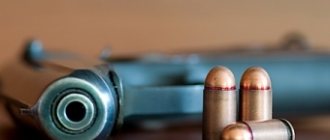Edged weapons are weapons that are used to hit a target using human muscle power through direct contact with the target. Such weapons can be piercing, slashing, piercing-cutting, crushing, and the like. Therefore, edged weapons include Finnish knives, daggers, knives, checkers, sabers, stilettos, brass knuckles, dirks and other objects that are specially adapted or directly intended to hit a living target.
Weapons are not products that are certified as products for industrial or household purposes. These are garden, shoe, kitchen, penknives and the like. You should know that there is responsibility for storing and carrying bladed weapons in 2022. This should be taken into account when purchasing metal products of a piercing or cutting nature. The issue of recognizing a certain object as a cold weapon is decided by forensic examination.
Distinctive features of edged weapons
Melee weapons have the following distinctive features:
- blade length is over 90 mm;
- blade thickness is over 2.4 mm;
- the angle of convergence of the butt and blade is no more than 70 degrees;
- the blade roll is no more than 9 mm;
- steel hardness is at least 25 Rockwell;
- the blade penetrates to a depth of at least 20 mm;
- there is a pronounced limiter for the fingers;
- the tip of the blade, which is convenient for stabbing in the presence of the other above point;
Edged weapons can be recognized as such only based on the results of certification or forensic examination. Punishment for carrying a bladed weapon may occur in the absence of a permit.
Responsibility for illegal possession, carrying or manufacturing
There is no point in citing articles: No. 222 and No. 223 of the Criminal Code of the Russian Federation; they are freely available on the Internet. If a crime has occurred, then there is no point in conducting an examination; a person was killed with this object and that’s all. Take the situation of simply carrying a blade without documents, law enforcement agencies love to conduct various checks.
This is especially true for souvenirs and homemade products. Be careful and vigilant with such items. If it is proven that this is a chemical weapon, according to the law, for illegal carrying or storage, a fine of 500 to 200 rubles and deprivation of a permit for a period of 1 year are imposed.
With production and sales, there are other significant difficulties in the form of: compulsory labor for up to 480 hours, correctional labor for up to 2 years, or imprisonment with a fine of 80 thousand rubles. or without it. According to law enforcement officers themselves, such cases rarely reach actual prison terms.
What bladed weapons are prohibited?
The article of the Criminal Code of the Russian Federation on the carrying of edged weapons prohibits the circulation as service weapons, including civilian weapons, of boomerangs, shurikens, brass knuckles, flails, as well as other objects specially adapted for use as weapons with throwing and impact-crushing action. In Russia, according to Article 6 of the weapons law, the circulation of the following weapons as service weapons, including civilian weapons, is prohibited:
- knives and bladed weapons, blades and blades have a length of more than 90 mm:
- are removed from the handle automatically by pressing a button or a special lever, and are also fixed by them;
- are extended using accelerated movement or gravity, and are also locked automatically.
How to wear and store correctly
Carrying a knife is not regulated in Russian legislation. There are places where it is better not to go with a blade. The law does not prohibit doing this, but there is simply a security service or just common sense. Places with large crowds of people, concerts, sporting events, etc. SB cannot be passed with a blade.
It's better to leave it at home or in the car. If you were smart enough to bring a knife to such an event, you don’t need to “shine” it. In the Russian Federation, wearing it is not regulated, but you should not walk around with a blade “for show”. Attracting attention to yourself.
It looks defiant and risks communication with law enforcement agencies. If you hide a knife in your sleeve or behind your back, if something happens, you may be accused of secrecy. It’s easier to hang it on your belt and cover it with a piece of clothing.
Difficulties may arise if you decide to travel by air. Having all the documents for the knives, present them, and the products must be checked in as luggage. You cannot bring even the slightest object of a piercing or cutting nature into the salon. In a situation where there is no documentation for the blade, it will be confiscated from you and placed in temporary storage.
Box for storing knives.
And upon return they will be required to give it back upon presentation of all papers. It happens in Russia, a knife can get lost, seeing it again is a question. There will be no problems with sea transport. The main thing is not to display your “pointy-nosed friend” in front of everyone, and when talking with law enforcement officers, behave with dignity. Everything will be resolved in a positive way.
What bladed weapons are citizens entitled to have?
The rules for carrying edged weapons require a license for it.
- Citizens who have permission to carry, including storage of hunting firearms, have the right to purchase hunting bladed weapons. When purchasing this weapon, the seller notes the entry in the citizen’s hunting license. In this case, a permit to carry this bladed weapon will be a permit to carry a hunting weapon.
- Some citizens can also buy bladed weapons, which are used to wear with the national costumes of the peoples of Russia, as well as Cossack uniforms. These are daggers, knives, checkers and sabers. The Russian government determines the attributes of national costumes.
In other cases, carrying edged weapons is prohibited.
About blades prohibited for circulation on the territory of the Russian Federation
By law, any types of knives with a blade length of up to 90 mm inclusive (but not a millimeter more!) are not edged weapons; therefore, a license to purchase and permission to carry a blade are not required.
If the length of the blade is exceeded by at least 1 mm, certain types of knives (see Article 6 of the Federal Law-150 “On Weapons” ), for example, balisongs - “butterfly” knives, become items prohibited for circulation on the territory of the Russian Federation, without being cold steel.
Important! In GOSTs you can find a description of knives that are not edged weapons, but are prohibited for circulation on the territory of the Russian Federation at any blade length. We are talking about so-called dagger knives with a double-sided blade sharpened along the entire length. It is prohibited to manufacture (read – and export from outside the Russian Federation) skinning and tourist knives with dagger blades.
It is allowed to sharpen tourist and special sports knives by the edge of no more than 1/3 of the blade length, and cutting and skinning knives by 2/3 of the length. Dagger knives in the household segment cannot be certified according to any of the regulations of the Russian Federation.
What to do with old knives
The problem of disposing of old knives is no less pressing than all others. On the one hand, there is no point in storing things in the house that are not suitable for use. On the other hand, shackled by numerous superstitions, people are afraid to throw away old or broken knives.
What to do in this case is suggested by folk signs. You can clean it and throw it into a river with running water, throwing in a couple of small coins after it. Or bury it somewhere in the garden. But if a damaged knife goes straight into the trash container, then there won’t be much trouble. This solution to the issue is quite acceptable.
Folding knives
Based on what was written above, it seems that only knives with a fixed blade are edged weapons. However, many people also use folding knives when hunting. Can a folding knife be considered a bladed weapon in Russia and what kind of knife will it be? Yes maybe. Hunting knives, that is, civilian bladed weapons, may include folding knives, the blade of which is not completely retracted into the handle when folded, provided that its length is at least 150 mm, and all the necessary requirements for the safety of the handle in such a knife are met. .
Such knives will require a special sheath to carry them, and they fold not for the purpose of safely storing the blade, but simply to save space. Any other folding knife, regardless of design, if the length of its blade does not exceed 150 mm, and the blade is completely retracted into the handle, by definition does not belong to a bladed weapon.
Let's start with history
Let us turn to the personal experience of one of our authors, Mikhail Kotov.
Mikhail Kotov
2001, I, a FINEK student, went at the beginning of autumn to orienteering in memory of Okinchits. We met on Vladimirskaya in the metro and a police officer stopped me there. They took him away, searched through the backpack, found it, quickly called witnesses - and off they went. I sat in the cage for 14 hours; late in the evening, when my dad and the state lawyer came for me, I was already in absolutely no condition and signed everything that was given (there is no need to talk about my legal literacy now: I had none).
I was released on my own recognizance. I don’t remember the article number now - storage and acquisition of edged weapons. The knife was bought in the Chita region - a hatchet knife with a replaceable blade, which was fixed with screws. I lived for a couple of months, nothing happened, when suddenly the investigator started calling me at the university, saying that she couldn’t find me and really wanted to change the measure of restraint to arrest.
Knife-axe produced by MOOiR was sold in hardware stores
Mikhail Kotov
At the university, as soon as they found out, they immediately informed me that I was here, they were looking after me, and a couple of hours later they handed me a package with certificates, positive recommendations and even a visit log made on my knee, that I was not playing truant and studying all the time (here they are were more proficient). We found a normal lawyer, he immediately said that I needed to write a refusal to testify, give new ones, that I did not know who collected the backpack, and was not aware that there was a knife there.
We went with a lawyer to the investigator. She immediately started yelling that she would put me behind bars, that she was dreaming about it and that today she would personally ask the prosecutor to change the preventive measure. The lawyer immediately asked to include this entire tirade into the case - and a couple of her later remarks. My aunt instantly calmed down, and I changed my testimony. Yes, they gave me the case materials to read, the examination recognized the knife as chemical, so everything was serious.
A couple of months later, my dad (he served as a major, flight director in the air regiment) received a request through the commander to come to the military investigator. The commander immediately began to look for what and how he could do, but for now they decided that dad would just go and get acquainted.
Dad said - I come to the investigator, there is a lieutenant sitting there, all the walls are in quotes from Dzerzhinsky and all that. We talked. The last phrase was: “Yesterday a conscript stole a machine gun from us, killed three colleagues and stole a UAZ, and here you are with your knife. Let's close it."
The case was closed for lack of evidence of a crime...
There are two points worth noting in this (undoubtedly true) story.
Firstly, the knife-axe, manufactured by the Industrial Plant of the Moscow Society of Hunters and Fishers (PC MOOiR), was actually sold anywhere. Including in ordinary hardware stores - I myself witnessed this.
Secondly, the date of the incident. Since Soviet times, there has been liability for the manufacture/storage/carrying/transportation/sale of bladed weapons (Article 218 of the 1960 Criminal Code). Almost any homemade product was considered a crime, the same applied to factory folding knives with a blade locking mechanism.
There were hunting (licensed) knives in the USSR (albeit of rather crappy quality): they were purchased in specialized stores upon presentation of a hunting license - and entered there, in a special column.
Hunting knives manufactured by PC MOOIR (USSR)
However, in the 2000s, foreign goods entered the market in large quantities, and domestic producers tried to keep up. The number of “sharpened pieces of iron” in the hands of citizens exceeded all reasonable limits (by Soviet standards, of course). At the same time, let me remind you that the surge in crime in the 90s greatly increased the load on penitentiary institutions - “there is nowhere to sit.” Also, collecting cold stuff has become quite popular among the wealthy and advanced part of the population.
Legislators had to urgently change the situation, and in 2004, amendments were made to the Criminal Code of the Russian Federation, according to which cold turkey was decriminalized to a certain extent.
The rules for purchasing by citizens aged 18 to 21 are being tightened.
In accordance with the current rules, in order to purchase a product (firearm, smoothbore, hunting, sports), it is enough to reach the age of eighteen and obtain a hunter’s license.
The Government is currently considering a project aimed at limiting purchase opportunities for adults under 18 years of age. The change is due to the need to reduce turnover, as well as the psychological characteristics of the development of adolescents at this time.
It is proposed to prohibit the issuance of weapons to those persons who have not served in the army, and also for whom hunting is not a means of legal profit.
The document is still under consideration, so there is no reliable information yet whether it will be accepted.
